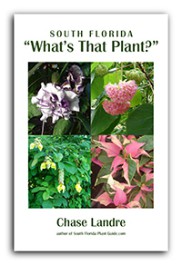Clumping Bamboo
Bambusa spp.
Clumping bamboo is non-invasive, available in a wide array of spectacular varieties, and creates the landscape look of a tropical paradise.
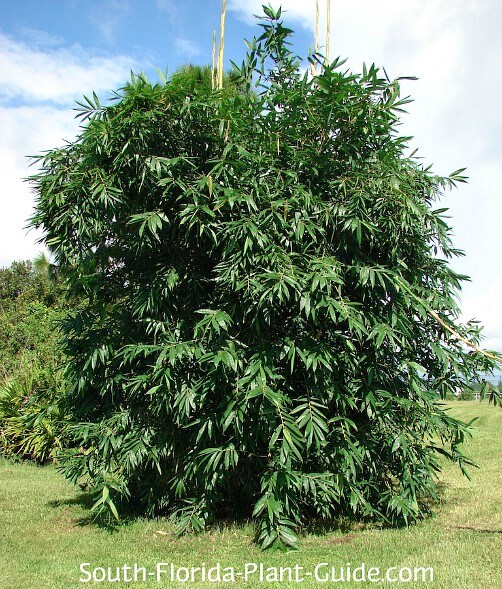
There is no South Florida plant as impressive as bamboo.
From dwarf varieties to "Giant Timber" this is one of the most exotic, beautiful, and fast growing plants for home landscapes.
Clumping varieties will expand outward from the original plant...unlike the very invasive running bamboo, which sends out shoots underground to pop up in surprising and inconvenient places.
Some cultivars grow more open with visible canes (known as "culms"), while others are very dense and bushy with foliage extending to the ground.
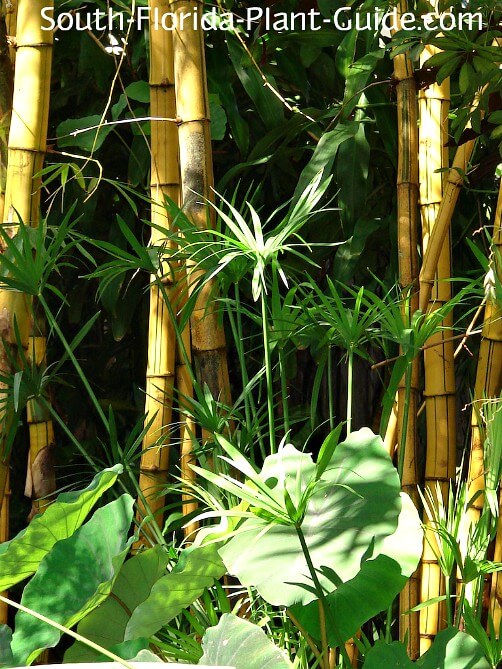
Besides its good looks, clumping bamboo is a long-lived, hardy plant that thrives with minimal care. It can be used for privacy, shade, as a backdrop or focal point.
Planting bamboo is a long-term commitment.
These plants, once established, are nearly indestructible.
In fact, after the atomic bomb was dropped on Hiroshima in 1945, a bamboo grove at the point of impact began sprouting new shoots in a matter of days!
You must provide enough space for clumping bamboo to grow new canes and spread out.
Choose the type that fits your space and has an ultimate height you can live with.
When you go to the nursery to buy bamboo, expect to come home with a somewhat sparse and scraggly-looking plant that you just paid a pretty penny for.
Young bamboo in a pot looks totally different than it will in even a year's time in the ground.
The musical sounds of bamboo are pleasant and enjoyable to most people (though not all).
Canes clunking together in the wind can produce a gentle, hollow knocking sound.
If the canes are very close together, the breeze moving them against each other creates a distinct kissing sound.
And the wind ruffling the leaves like feathers makes a soft, whirring noise.
Popular Tropical Bamboo Varieties
- Giant Timber (Bambusa oldhamii) Grows 40 to 60 feet with large green canes.
- Wamin "Dwarf Buddha Belly Bamboo" (Bambusa vulgaris 'Wamin') An open-growth plant with very noticeable "bellied" canes. It grows 15 to 20 feet.
- Mexican Weeping (Otatea acuminata) Super-fine textured, fluffy plant with a weepy appearance. It can get 15 to 20 feet tall.
- Alphonse Karr (Bambusa multiplex 'Alphonse Karr') Showy golden-yellow canes with green pinstripes that vary on each section. Grows 20 to 30 feet.
- Slender Weavers (Bambusa textilis var. gracilis) A distinctly upright grower with thin canes and a compact base, great for smaller areas. It grows 30 to 40 feet.
- Golden Goddess (Bambusa multiplex 'Golden Goddess') A small but full variety with slender yellow canes. Grows to about 15 feet.
- Blue Bamboo (Bambusa chungi) Soft blue canes covered with a powdery coating while young. Grows to 30 to 40 feet.
- Black Bamboo (Phyllostachys nigra) Striking black canes on an open-growth bamboo. Grows about 20 to 25 feet.
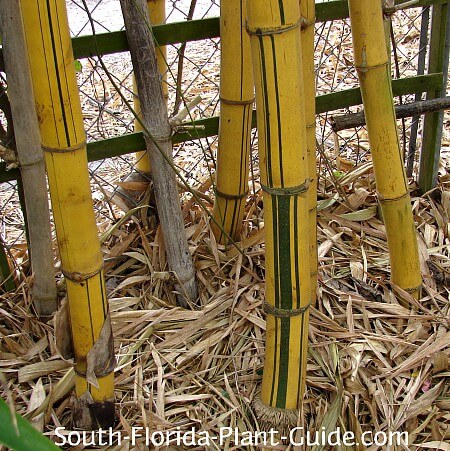
Plant specs
Clumping bamboo prefers sun to part shade - with at least 4 hours of sun per day.
Most varieties are cold-tolerant and will do very well in Zone 9B or Zone 10.
Bamboo grows with gusto - an extremely fast grower from newborn shoot to full-size cane within 60 days.
The new shoots, which emerge the same thickness they will be when mature, are vulnerable to rough treatment so avoid damaging them.
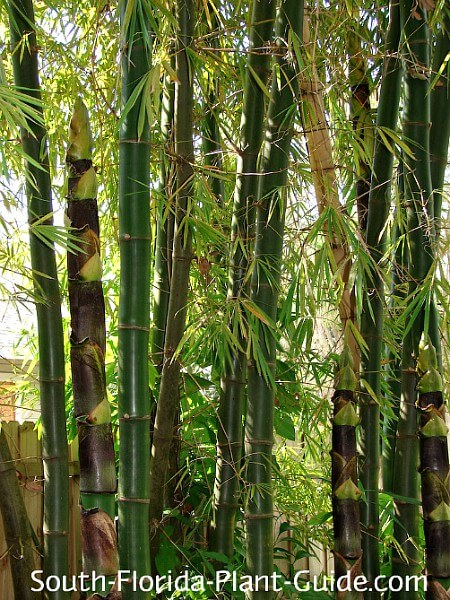
Plant care
Bamboo care is easy once the plants have been well-established (about a year in the ground).
Add organic peat moss and composted cow manure to the hole when you plant.
No trimming is needed. However, if bamboo shoots are coming up where they're not wanted, cut them off at the base.
Water on a regular basis. The planting area should drain well but these plants like consistent, even moisture.
Situate the plant in such a way (if you can) where the base stays a bit shaded and the top gets good sunlight.
You can mulch heavily to help retain moisture in the soil around the plant's base.
If the leaves are curling, the plant isn't getting enough water. This is imperative during the first year in the ground.
After that, the plant is somewhat drought-tolerant, though regular watering keeps it attractive and the foliage green.
A newly planted bamboo may drop leaves initially - don't worry, new ones will soon emerge to fill in.
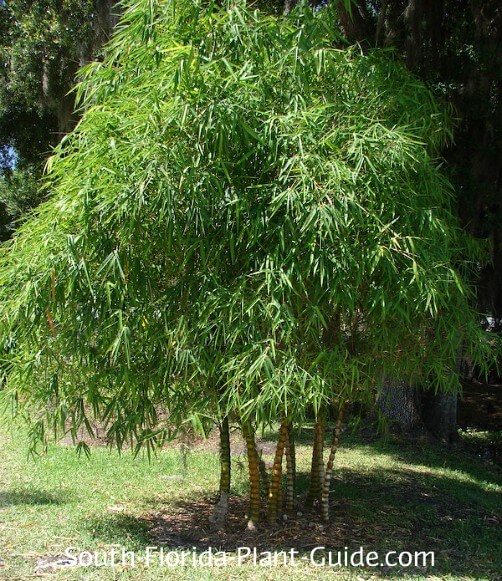
Bamboo can be messy. VERY messy. Dried and fallen leaves can blanket the earth (or patio or road) around the plant. Avoid placing bamboo near an open pool for this reason.
You can generally whisk away the lightweight dried leaves with a leaf blower.
Some leaf stalks - known as culm sheaths - may fall off the canes and will
have to be picked up. Regular waterings and planting in the right spot
minimizes the mess. (Note: Wear gloves when handling leaf stalks, since tiny hairs on them will irritate your skin.)
Fertilize with a good-quality granular palm fertilizer 3 times a year - in spring, summer and autumn.
This plant can get mealybug, but no treatment is necessary. Mealybug is no match for bamboo.
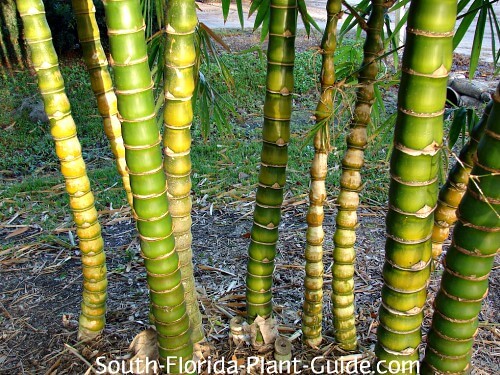
Plant spacing
This depends on the variety, but as a general rule of thumb when growing a "hedge" of bamboo, space plants 5 feet apart.
Again, depending on which of the clumping bamboos you're planting, place it 5 to 12 feet (or more) from the house,
Ditto for the nearest garden plant, the sidewalk and the drive.
Larger varieties should go in at a safe distance from the house where they won't hit it if they bend in a strong wind.
Forget growing bamboo in a pot - it's way too fast a grower and needs its feet on the ground.
Landscape uses for clumping bamboo
- single yard specimen
- hedge
- backdrop for other tropicals
- privacy screen
- shade
- windbreak (larger varieties)
GOOD SNOWBIRD PLANT? YES (with year-round irrigation)
COMPANION PLANT SUGGESTIONS: Ruella ("Mexican Petunia"), papyrus, white bird of paradise, macho fern, elephant ears, heliconia, hair grass, walking iris, and selloum philodendron.
Other plants you might like: Areca Palm, Arenga Palm
Take a break!
The ultimate guide to low-maintenance plants
and landscaping!
An ebook by
Chase Landre
author of
South-Florida-Plant-Guide.com
Learn more!
Get a greener thumb!
Want to learn more about South Florida planting, watering, fertilizing and dealing with weeds and pests?
See our Gardening How-To section for answers!
Get instant curb appeal!
An ebook by
Chase Landre
author of
South-Florida-Plant-Guide.com
Learn how to get instant curb appeal with fast growing plants and landscaping techniques!
